Introduction
The Contax/Kiev mount is a lens mount for rangefinder cameras first used by the 1932 Contax rangefinder, and later taken over by the Soviet Kiev rangefinder (a Soviet version of the Contax). The mount is also sometimes referred to as the Contax rangefinder or Contax RF (even CRF) mount.
Contax/Kiev mount specifications
Mount type: Dual Bayonet (inner and outer) (lens release on body (inner bayonet); lens release on lens (outer bayonet)
Flange focal distance: 34,85 mm
Film format: 36mm x 24mm (‘Full frame’)
Mount communication: One internal slotted cam for communicating distance information to camera’s rangefinder apparatus (lens-to-camera).
Basic Information on the Contax / Kiev mount
The Contax / Kiev mount has its origins as far back as 1932, when Zeiss Ikon introduced the first Contax rangefinder camera. The camera mount remained largely unchanged through subsequent iterations of the Contax rangefinder camera (both pre-war and post-war) and when in 1947 the Arsenal plant (in Kyiv, Ukraine) started using tooling and parts taken as war reparations from the Zeiss Ikon plant in Dresden, the Contax rangefinder started making rounds as the Kiev rangefinder. While the production of the original Contax rangefinder ceased in the early 1960’s, production of Kiev rangefinders ended only in 1987.
“Contax” is one of the most illustrious names in camera history, and it is no surprise that the name has been avidly repurposed. While some of the later iterations have been a family of Japanese SLR’s (see more here) or two, a family of Japanese high-quality compacts (the Contax T-series) and a ‘modern’ autofocus film rangefinder (the Contax G, see more here), the original Contax was this: the 1932 Zeiss Ikon Contax.
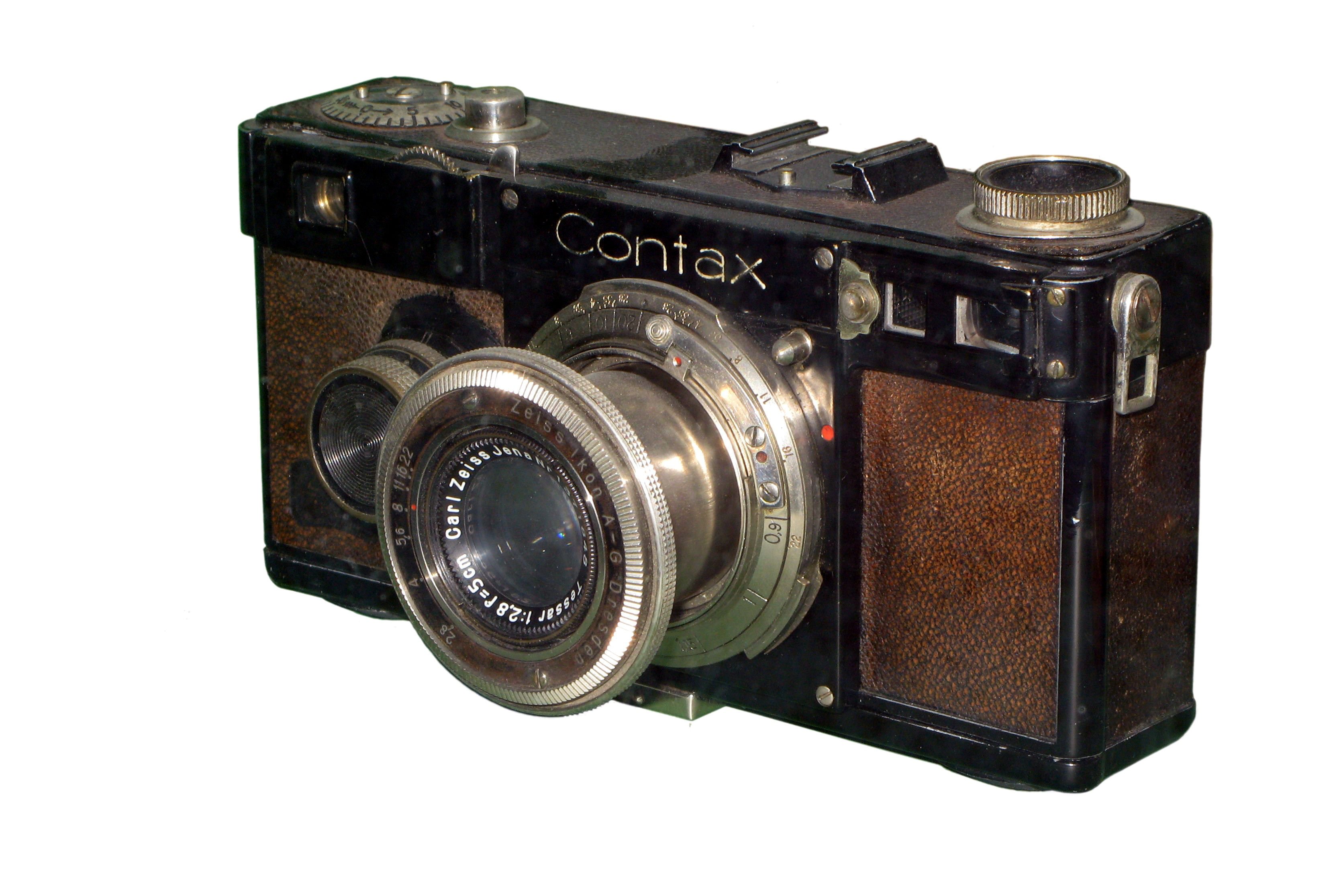
Shared under CC BY-SA 2.0 fr
The fact that the Contax -name has had such tremendous staying power is the strongest testament to the success of the Contax rangefinder. That said, the original Contax (I) camera was not entirely untroubled. While groundbreaking and in many respects easily a match for the contemporary Leicas (the competition Zeiss Ikon set out to beat), early versions did suffer a lot of mechanical issues. But there was one aspect of the Contax Rangefinder that did not necessitate a change for the entire 55-year life-span of the Contax / Kiev line of cameras: the lens mount. Another testament to the qualities of the Contax / Kiev mount is that Nikon used the Contax / Kiev mount as a blueprint for their own rangefinder lens mount (the Nikon S mount) 1.
The lens mount is an ingenious, if somewhat quirky, combination of a simple inner bayonet mount that has an integrated rangefinder coupling and integrated focusing, and an outer bayonet mount that does allow using a wide range of focal lengths, but that simultaneously can engage with the rangefinder coupling facilitated by the inner mount. Explaining how this works is easiest if we start by looking at the camera-end of the mount:
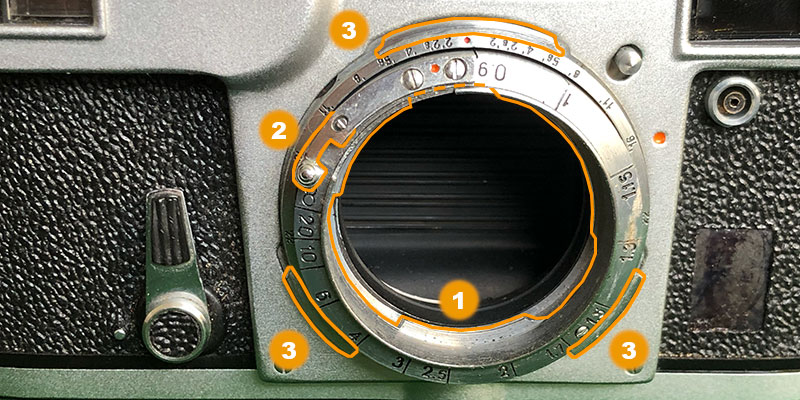
[1] Inner bayonet (three prongs), partly obscured
[2] Inner bayonet hold-down clamp
[3] Outer bayonet (three-pronged)
The inner bayonet on a Contax / Kiev camera is intended to rotate in its entirety (including the lens). The rotating motion is coupled to the rangefinder, while the rotating motion also shifts the lens away from the film plane, thereby facilitating focusing.
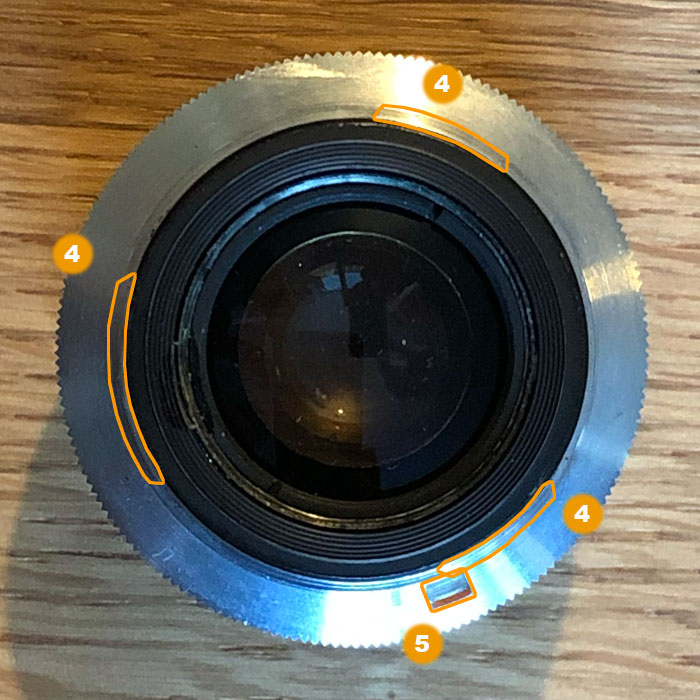
Please note, as the Contax / Kiev inner bayonet rotates, lenses have no real up of down.
[4] Three-pronged bayonet (engages with three-pronged inner bayonet (1))
[5] Inner bayonet lock pin (locks with inner bayonet hold-down clamp (2))
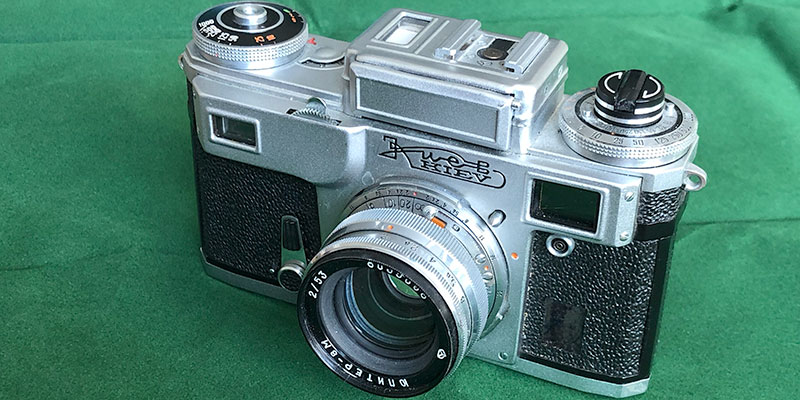
Observe how the lens’ locking pin is grasped by the inner mount’s hold-down clamp.
While simple and elegant, this has three limitations:
a) Firstly, this method of focusing necessitates that the entire lens rotates around the optical axis, meaning that inner bayonet lenses have no obvious “up”. To address this, inner bayonet lenses often have duplicate aperture scales (one on each side of the lens) in the hope that at least one of the scales will be visible whatever the lens’ rotation
b) another obvious limitation is that for the rangefinder to hold true, the relationship between distance increase (exit pupil to film plane) and rangefinder distance scale need to be constant. In other words, this only functions with one focal length (not surprisingly Zeiss Ikon settled on ≈ 50 mm). Lenses of significantly other focal lengths cannot depend on the inner mount.
c) Finally, as for the rangefinder to be able to work independent on which lens is mounted, the rangefinder needs to be set for a specific distance range. In the case of the Contax, a distance range of 0,9 meters to infinity was chosen. This does not mean that shorter distances would be impossible, just that rangefinder coupling cannot work for objects closer than MFD.
Therefore any lens that has a focal length sufficiently different from 50 mm or a lens that is not to be used with the coupled rangefinder must use the outer bayonet. The outer bayonet does not rotate, but if the lens is designed to include an inner barrel that engages with the inner bayonet’s prongs, and rotates in tandem with the lens’ focusing ring a lens mounted on the outer bayonet can still use the rangefinder functionality supplied by the inner bayonet, assuming that the lens’ focusing throw/focusing movement is calibrated to match that of the inner bayonet’s focusing scale (see distance scale on outer edge of inner mount).
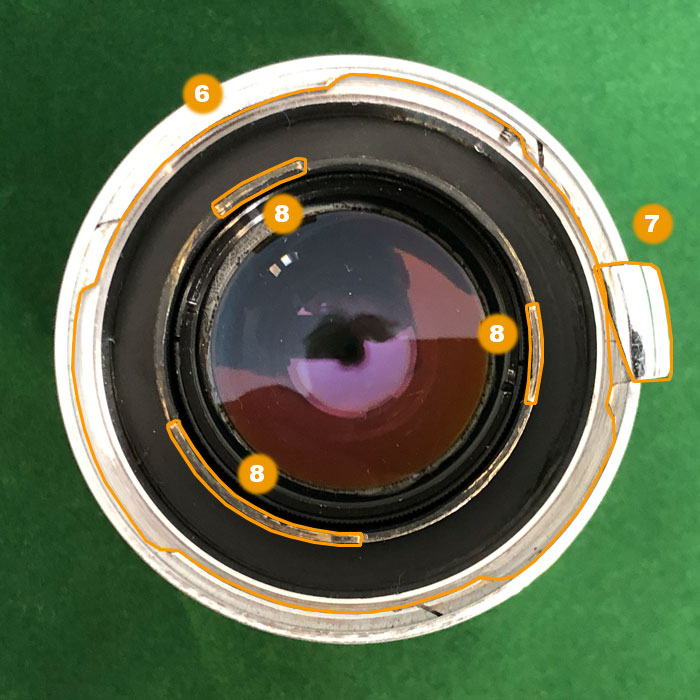
(Lens’ upside at 6 o’clock)
[6] Three-pronged bayonet (clamps onto outer bayonet)
[7] Outer bayonet release clamp
[8] Inner tube (engages with rangefinder mechanism).
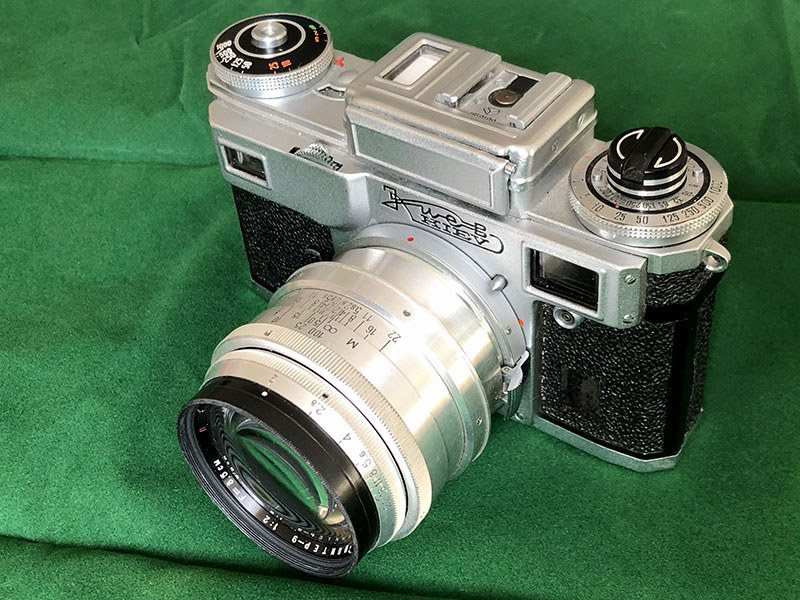
Observe how the lens’ outer bayonet entirely obscures the bayonet mount and distance scale. At the same time, focusing the lens using the lens’ focus ring adjusts the body’s rangefinder mechanism.
While fantastically elegant, especially considering the lens mount’s 1930’s origin, the lens mount does lack some more modern finesses (such as a way for the body to know the lens’ focal length and highlight suitable frame lines in the viewfinder/rangefinder)
Adapting Contax / Kiev mount lenses
Considering that the Contax mount was one of the most prominent lens mounts from its inception to the 50’s (when both Zeiss’ increasingly started focusing on SLR’s and other, non-rangefinder cameras), it’s no surprise that the Contax / Kiev mount is host to some of the most exceptional pieces of legacy optics made over several decades. Further, with the sustained attention given to the Contax / Kiev mount by its adoptive parents (the Soviet lens industry) there are also lenses sporting relatively modern coatings to choose from. In short, there might be a lot of lenses one would want to give a new lease on life.
While the Contax / Kiev mount’s flange focal distance (at 34,85 mm) is not as prohibitive as many other rangefinder mounts (28,8 mm for LTM; 27,8 mm for Leica M), it is nigh impossible to adapt Contax / Kiev lenses to SLR’s of any description.
However, when adapting Contax / Kiev lenses to mirrorless cameras, flange focal distances are in your favour. One merely needs a suitable adapter…
Interestingly, that is less straightforward than it sounds, especially if you’ll want to also be able to adapt Contax / Kiev lenses that are intended to be used on the internal mount (that do not have a focusing mechanism and depend on the internal mount). Few of the major-brand adapter manufacturers produce Contax / Kiev adapters, and those that do offer primarily outer bayonet adapters. As of this writing (summer 2025) I am aware of only one major-brand Contax / Kiev to full-frame mirrorless adapter that supports both inner and outer mounts, and it is not cheap…
On the other hand, there have been enterprising lens hackers (especially in the Ukraine, so that supply might also be constrained) that have used derelict Kiev cameras to manufacture fully functional and quite affordable DIY-adapters for most mirrorless mounts.
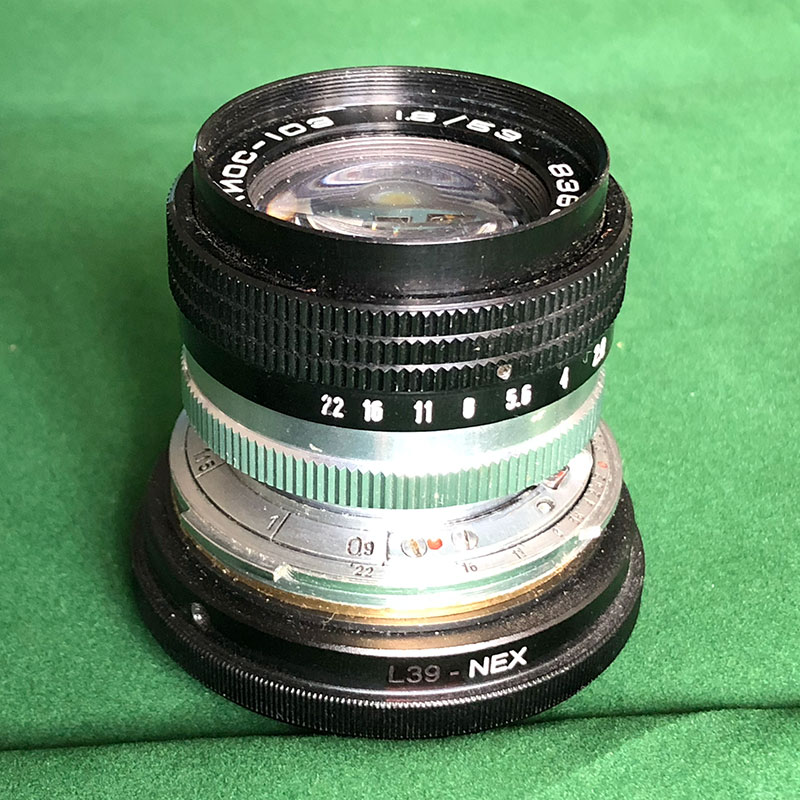
As is plain to see, this adapter is a shotgun marriage of a LTM–>NEX adapter and a Contax / Kiev mount ripped out of a Soviet Kiev camera. Is it elegant? Not unless you’re into brutalism. Does it work? Splendidly. Moreover, this sample’s infinity focus is bang-on, and it supports both inner and outer bayonets. Unless you have several absolute classic lenses (like a 75/1.5 Biotar) in Contax / Kiev mount lying around, this approach is by far the most sensible.
Identifying the Contax / Kiev mount
Footnotes:
1 The Nikon S mount is closely related to the Contax / Kiev mount, and while some lenses can be used interchangeably on both mounts, the mounts do have differences. These differences do not preclude cross-mounting Contax/Kiev and Nikon S lenses, but they do lead to that when lenses are cross-mounted the rangefinder is off by a couple of percent. Hence, I class the Contax/Kiev and Nikon S mounts only as related (and not identical). Therefore, this article is intended to cover only the Contax / Kiev mount (some day the Nikon S mount may get its own article).
Hello. Please accept my thanks for such a thorough debriefing. I recently acquired this lens and have been hunting desperately for the appropriate Contax/Kiev to L mount adapter. Thanks to your article, I believe I’ve found one – based in the US, too.
If you don’t mind my sharing a link here, in case others are on the prowl for it, see below. It’ll set folks back about $200. But it is domestic.
https://fotodioxpro.com/products/cba-l-pls?_pos=3&_sid=12ba42fac&_ss=r
Cheers!
Iman
Hi Iman.
Thank you for bringing this to our attention. It seems Fotodiox currently offers Contax/Kiev adapters with both outer and inner bayonets for all major mirrorless mounts (Canon RF, Fujifilm X, L-mount, MFT, Nikon Z, Sony FE) as well as Leica M and Fujifilm G and Hasselblad X digital medium format mounts. This is a marked improvement as last time I had scoured the net, the adapters I found were either the Ukrainian DIY adapters mentioned in the article or an even more expensive major brand offering.
While a US product is domestic only for ≈5% of the world, the product you’ve found is certainly an option.
Thanks again,
Pekka